-
- Global AMC MENU
- NEWS
- HEALTH
- PEOPLE
- Introduction

▲ (from the left) Professor Yong Sik Yoon and Professor Jong Lyul Lee
Crohn's disease, which causes recurring inflammation throughout the intestines, often leads to serious complications such as intestinal obstruction, fistulas, and abscesses, necessitating surgical intervention, particularly in cases of severe bleeding. However, due to the disease’s recurrent nature and high complication incidence at the surgical site, as many as 25% of cases require reoperation, lowering patients’ quality of life.
A research team led by Professor Yong Sik Yoon and Professor Jong Lyul Lee of the Division of Colon and Rectal Surgery at Asan Medical Center (AMC) devised and applied a new surgical approach for Crohn’s disease that modifies the direction of the anastomosis that rejoined severed intestinal segments. The application resulted in significantly improved prognoses compared to the traditional method, reducing complication rates and the incidence of intestinal obstruction.

▲ The traditional Conventional Stapled Anastomosis (left) and the new Delta-Shaped Anastomosis designed by the team led by Professor Yong Sik Yoon (right).
Surgery for Crohn’s disease requires resecting and suturing a section of the intestine. The Delta-Shaped Anastomosis (DSA) developed by the research team connects the resected segments vertically at a 90-degree angle, creating a connection that resembles the Greek letter delta (Δ). This modification improves the flow of intestinal contents and prevents the accumulation of food or waste around the surgical site, addressing the limitations of the traditional method, known as Conventional Stapled Anastomosis (CSA), which joins the intestine horizontally.
The research team conducted a follow-up observation on 175 Crohn’s disease patients who underwent bowel resection at AMC between 2020 and 2023 for an average of 20.7 months. Of these, 92 patients underwent the new DSA, and 83 underwent the traditional CSA. The study results showed that the DSA group patients had a postoperative complication rate of 16.3% within 30 days, nearly half the rate of 32.5% in the CSA group. The incidence of intestinal obstruction was also lower in the DSA group (4.3%), more than two-thirds lower than the CSA group (14.5%), and the length of hospital stay was 5.67 days in the DSA group compared to 7.39 days in the CSA group, indicating the DSA group’s faster recovery.
Professor Yong Sik Yoon noted, “The new Crohn’s disease anastomosis technique is expected to play an important role in improving the postoperative quality of life for Crohn’s disease patients.”












